
  
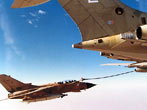  
  
  
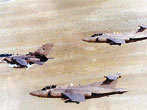  
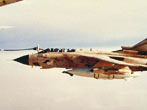  
  
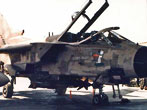  
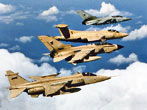  
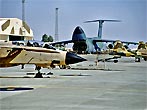  
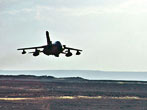  
  
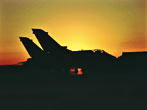  
|
 |
1990/91 The Gulf War - Operation Granby and RAF Tornado Dawn Tabuk
This Time Line documents the major events that took place in and outside the Gulf theatre between 2 August 1990 and 11 April 1991.
2 August 1990 - Iraq invades Kuwait; UN condemns invasion and demands Iraqi withdrawal Saddam Hussein's Iraq begins invasion of Kuwait at 0200 hours local (2300 1 August GMT).
3 August 1990 - US despatch naval force to the Gulf.
6 August 1990 - UN imposes mandatory comprehensive sanctions on Iraq.
8 August 1990 - US announces first deployments in response to request from Saudi Arabia. Iraq formally annexes Kuwait. First US troops arrive in Saudi Arabia to meet threat posed by Iraqi troops massing on border.
9 August 1990 - UK announces first deployments of Tornado F3s and Jaguars to join Armilla patrol in the Gulf. UN declares annexation invalid. Defence Secretary Tom King announces that UK is to send Tornado and Jaguar squadrons to the Gulf; together with other aircraft, Rapier SAMs and 1,000 support personnel. Group Captain R S 'Rick' Peacock-Edwards and advanced party arrive at Dhahran, Saudi Arabia, to prepare for arrival of RAF detachment. Units include Mobile Air Movements Squadron, No 34 Squadron RAF Regt for ground defence and security; Mobile Catering Support Unit; Tactical Communications Wing and the Army's 30 Signals Regiment. Subsequent arrivals include Tactical Supply Wing and No 1 Aeromedical Evacuation Squadron. AVM RAF 'Sandy' Wilson is Air Commander British Forces Arabian Peninsula with HQ at Riyadh, Saudi Arabia. RAF transport force begins supporting Operation Granby. VC10-C1s of No 10 Squadron, Brize Norton; Tristars of No 216 Squadron, Brize Norton; Hercules of Nos 24, 30, 47 and 70 Squadrons, Lyneham. Initial Lyneham commitment is 27 Hercules and 57 crews.
11 August 1990 - 11 August 1990 First British aircraft arrive in Saudi Arabia. No 5 (Composite) Squadron arrives at Dhahran from Akrotiri, Cyprus, led by Wg Cdr Euan Black and comprising six Tornado F3s of No 5 Squadron and six of No 29. A further ten Tornados left on Cyprus, where units had been based for armament practice. No 6 (Composite) Squadron led by Wg Cdr Jerry Connolly, with 12 Jaguar GR1As, including four in reconnaissance configuration, leaves Coltishall for Thumrait, Oman, arriving on 12 August. Aircraft have been painted in Pink Panther desert camouflage scheme. No 20 Squadron, RAF Regiment, leaves for Cyprus with Rapier air defence missiles. Later transfers to Bahrain.
12 August 1990 - First Nimrod MR2P leaves Kinloss for Seeb, Oman, to help enforce the maritime blockade. Detachment led by Wg Cdr Andrew Neal. VC10 tankers of No 101 Squadron installed at Seeb, Oman. Further detachments later positioned at Muharraq (Bahrain) and Riyadh International Airport (Saudi Arabia).
14 August 1990 - UK announces additional naval forces for Gulf.
17 August 1990 - Six Phantom FGR2s of Nos 19 and 92 Squadrons arrive at Akrotiri from Wildenrath, Germany, for local air defence, replacing ten Tornados of Nos 5 and 29 Squadrons.
22 August 1990 - US announces call-up of reservists.
23 August 1990 - Britain announces plans for despatch of Tornado GR1s to Muharraq, Bahrain, and replacement of Dhahran Tornado F3s.
25 August 1990 - UN calls for enforcement of sanctions by coalition naval forces.
27 August 1990 - No 14 (Composite) Squadron with OC Wg Cdr Vaughan Morris, leaves Bruggen, Germany, with 12 desert pink Tornado GR1s arriving at Muharraq (Bahrain) next day. Muharraq Commander is Gp Capt 'Rocky' Goodall.
29 August 1990 - Wg Cdr David Hamilton leads six Tornado F3s of No 11 (Composite) Squadron to Akrotiri arriving Dhahran on 30 August. Six more aircraft follow on 16-17 September. AVM RAF Wilson also becomes Commander British Forces Middle East (CBFME) as well as Air Commander (ACBFME).
14 September 1990 - UK announces deployment of 7th Armoured Brigade Dhahran Tornado F3 Squadron to be boosted by six aircraft and second squadron of GR1s to be sent announces Tom King.
19 September 1990 - Six Tornados from Laarbruch to Bahrain, followed by six more on 26 September for second unit here. No 617(C ) Squadron (Wg Cdr Bob Iveson).
22 September 1990 - Extra six Tornado F3s arrive at Dhahran for No 11 (C) Squadron, releasing last of No 5 (C) to return to UK. All 18 are to latest Stage 1 standard with upgrades to radar and self-defence aids.
25 September 1990 - UN imposes strict air embargo on Iraq.
28 September 1990 - British troops of 7 Brigade embark for the Gulf by sea, arriving 18 October.
30 September 1990 - Royal Navy in Gulf conducts first boarding of merchant vessel.
1 October 1990 - Lt Gen Sir Peter de la Billiere becomes Commander British Forces Middle East with AVM RAF Wilson as Deputy. Detachments of 30 Signals Regiment and Tactical Communications Wing at Dhahran combined as Joint Communications Unit.
3 October 1990 - Gp Capt John Rohum replaces Gp Capt Peacock-Edwards as Commander Dhahran Detachment.
9 October 1990 - No 617(C) Squadron moved to Tabuk, in West Saudi Arabia from Bahrain.
11 October 1990 - Tristar flies from Gutersloh, Germany, to Saudi Arabia, with advanced party of 7 Brigade. Main airlift starts 16 October using VC10s, Tristars and British Airways Boeing 747s.
18 October 1990 - Serious accident of Operation Granby, Tornado GR1 receives Cat 4 damage in landing accident at Tabuk and dismantled for return to UK.
23 October 1990 - Seven Jaguars leave Coltishall followed by five on 2 November to replace original aircraft based at Muharraq, Bahrain since mid-October.
24 October 1990 - Plans announced for despatch of Pumas.
28 October 1990 - European Community demands Iraqi withdrawal.
1 November 1990 - Three 'pink' Puma HC1s leave Brize Norton inside a USAF C5 Galaxy, followed by eight on 2 November and four on 3 November for No 230 (C) Squadron at Ras Al Ghar, Saudi Arabia. RAF base commander there is Gp Capt Sam Hunt. Pumas have been fitted with infra-red jammers, chaff/flare dispensers and enhanced navigation equipment. RAF Hercules begin flying routes within the Gulf theatre, using Riyadh as a central base. Typically four aircraft at any one time.
8 November 1990 - US announces substantial reinforcement of forces in Saudi Arabia.
14 November 1990 - No 66 Squadron, RAF Regiment, replaces No 20 at Bahrain taking over Rapier SAMs.
17 November 1990 - AVM W J 'Bill' Wratten replaces AVM Wilson as ACBFME and Deputy CBFME.
22 November 1990 - UK announces deployment of 4th Brigade, a divisional headquarters, and supporting units to form 1st (British) Armoured Division Britain announces 14,000 more troops to be sent.
24 November 1990 - Three 'pink' Chinook HC1s flown to Saudi Arabia inside USAF C-5 Galaxy transports from Mildenhall forming advanced party of No 7 (Composite) Squadron at Ras Al Ghar. Others sailed from Southampton on 23 December. All fitted with infra-red jammers and upgraded navigation equipment.
25 November 1990 - Equipment of 4 Brigade loaded in Germany for sea transport to Saudi Arabia. On arrival 4 and 7 Brigades form 1st Armoured Division.
29 November 1990 - UN authorises states to use all necessary means to secure Iraq's withdrawal unless Iraq complies with all UN resolutions by 15 January.
November - December 1990 - Rotation of personnel originally sent to Gulf: Dhahran Tornado F3 Squadron becomes No 43 (Composite) under Wg Cdr Andy Moin. No 6 (C) Squadron becomes No 41 (C) Wg Cdr Bill Pixton with Jaguars at Muharraq. No 14 (C) becomes XV(C) Wg Cdr John Broadbent with Tornado GR1s at Muharraq. No 617 (C) becomes No 20 (C) Wg Cdr Mike Heath with Tornado GR1s at Tabuk. New station commanders are Gp Capt David Henderson at Muharraq and Gp Capt Bill Hedges at Tabuk.
5 December 1990 - Iraq accepts US proposal for reciprocal meetings.
14 December 1990 - Victor K2 tankers No 55 Squadron left Marham for Muharraq, followed by three more on 15 December. Commander is Wg Cdr David Williams.
15 December 1990 - Iraq says it will not meet the US on 17 December.
23 December 1990 - Atlantic Conveyor loads at Southampton Docks with four Pumas and eight Chinooks as well as 12 RN Seakings. Arrives Jubail, Saudi Arabia on 8 January 1991.
30 December 1990 - Planned despatch announced of third Tornado attack squadron.
2 January 1991 - NATO approves deployment of air defence aircraft to Turkey. Six Tornado GR1s leave Bruggen for Dhahran to form No 31 (Composite) Squadron Wg Cdr Jerry J Witts. Others follow on 3 and 4 January. Aircraft have uprated engines, new IFF provision for 495 Gal (2,250 litre) drop tanks, GPS navigation equipment and other changes.
4 January 1991 - Iraq accepts offer of final talks.
8 January 1991 - Akrotiri based Phantom lost in the Mediterranean.
9 January 1991 - US Secretary of State meets Iraqi Foreign Minister in Geneva but several hours of talks fail to produce results.
13 January 1991 - UN Secretary General has fruitless meeting in Iraq. Tornado GR1 lost in a fatal flying accident in Saudi Arabia.
14 January 1991 - Six reconnaissance Tornado GR1As leave Laarbruch for Dhahran as No 2 (Composite) Squadron under Wg Cdr Al Threadgould. Now 42 Tornado GR1/1As in the Gulf.
15 January 1991 - UN deadline expires.
16 January 1991 - Tristar K1 arrives at Cambridge for repainting in 'desert pink'. Completed overnight and immediately departs for the Gulf.
17 January 1991 - Operation Desert Storm begins with air strikes against Iraq; first SCUD attacks on Israel and Saudi Arabia. RAF Tornado GR1s and tanker support take off on first attack mission at approximately 01.00 hours local (2200 GMT 16 January). Operation Granby had finished and Desert Storm had commenced.
19 January 1991 - Iraq releases oil into Gulf.
24 January 1991 - First indication of Iraqi aircraft fleeing to Iran.
12 February 1991 - Coalition shifts focus of air and artillery attacks to Iraqi forces in Kuwait.
15 February 1991 - Iraq says it will comply with UN demands, but attaches unacceptable conditions.
22 February 1991 - Soviet diplomatic efforts to secure peace fail, when Iraq refuses to consider unconditional acceptance of UN resolutions. Coalition issues statement setting out final terms for cessation of hostilities with a deadline for acceptance of 23 February. Iraq rejects this deadline.
24 February 1991 - Coalition launches ground offensive.
25 February 1991 - 1st (British) Armoured Division enters Kuwait; HMS Gloucester shoots down Iraqi Silkworm missile.
28 February 1991 - Kuwait is liberated, and coalition suspends offensive operations; Iraq agrees to comply with UN demands.
2 March 1991 - UN sets out conditions for end to hostilities.
3 April 1991 - UN sets out terms for formal ceasefire.
6 April 1991 - Iraq indicates acceptance of these terms.
11 April 1991 - Formal ceasefire comes into effect.
Gulf War Campaign Diary
The campaign over time from January till March 1991.
Source and Photo: raf.mod.uk
|